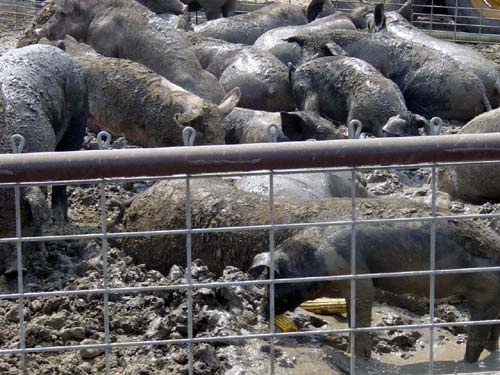 by PRESTON MACDOUGALL May 04, 2009
The WHO recently raised their pandemic alert to the fifth of 6 phases leading up to a global pandemic, the last of which ran its course from 1968 to 1969 and was estimated to have killed a million people - the majority in Hong Kong. Flu vaccination has become much more widely available since then, and public health systems have many more containment tools at their disposal - such as infrared cameras to measure the body temperatures of passengers disembarking from a plane. And for those that do get sick, there is the balm of Gilead Sciences - the California pharmaceutical company that developed the antiviral drug marketed as Tamiflu by Hoffmann-LaRoche.  influenza A viruses, pigs are biochemists too. Credit: morguefile.com But forewarned is forearmed, and with the ubiquity of cell phones and the Internet, I would think that people all around the world have their chemical defense systems, such as soap, Clorox, and Oseltamivir at the ready, even if their biological immune systems are unprepared. Amazingly, the legions of people who read Nicholas Kristof's columns in the New York Times, myself included, were eerily on alert for a swine-related epidemic one week before this one started. On March 11, Kristof reported on widespread cases of methicillin-resistant Staphylococcus aureus - better known as MRSA, or just "superbug" - in the small town of Camden, Indiana, which has several industrial-sized pig farms nearby. One week later, health officials in Mexico reported the first surge in illnesses that we now know were swine flu. The outbreak has been traced to the small town of La Gloria, in the Mexican state of Veracruz. Like Camden, La Gloria is near an industrial-sized pig farm. While I suspect that these two towns smell the same, the epidemics that they are suffering from are quite different. The MRSA infections are bacterial, and the swine flu infections are viral. And if you think chemistry class was complicated, the biochemistry of pathogen attack and immune responses is like chemistry on steroids. For instance, you might have heard that the bird flu was a H5N1 influenza A virus, while the swine flu is H1N1. And back in 1968, the culprit was H3N2. The H's and the N's do not refer to atoms of hydrogen and nitrogen like they do in N2H4, the chemical formula of hydrazine - or "rocket fuel" - which has two atoms of nitrogen and four of hydrogen in each peppy molecule. Viruses are much smaller than bacteria, but they are still complex assemblies of numerous and various molecules, many of which are large and complex themselves. All influenza viruses contain RNA molecules that encode their identity the way that our DNA identifies us. Just like some of our genes encode for the chemical composition of the protein molecules that determine hair color, certain influenza genes encode for recognizable chemical features on the external surface of a virus. Two of these types of large molecules are hemagglutinin (a protein/carbohydrate blend) and neuraminidase (a bond-cleaving protein enzyme), and these are what the H's and the N's of the flu type refer to. And just as there are different hair colors and eye colors, mutations of the virus lead to variations in the chemical compositions of these surface molecules. The numbers refer to common mutations of each molecule. There are many other types of molecules on the surface of a virus, just as people have many external features in addition to hair color. But H and N are the targets of our immune system and antiviral drugs such as Tamiflu, respectively, so they are commonly used to classify strains of the influenza virus. The variation in the strains is much more complicated than suggested by H5N1 vs. H1N1, but I would have to mutate into a virology professor to adequately explain it to you. Lastly, some of the swine flu
reporting has been a bit sloppy, and suggested that the new virus
has genetic make-up that "is a mixture of human, bird and
pig". What this refers to is the combination of RNA components
from human, avian and swine strains of the flu virus.
On the Web:
E-mail your letters & opinions to editor@sitnews.us SitNews ©2008 Stories In The News Ketchikan, Alaska |